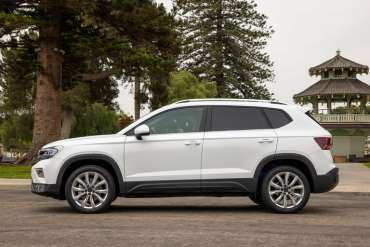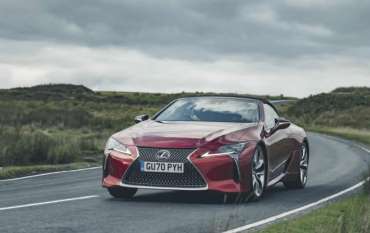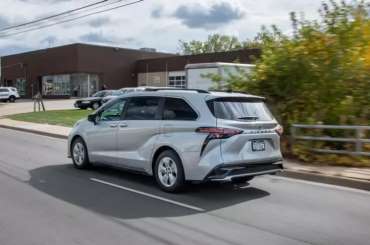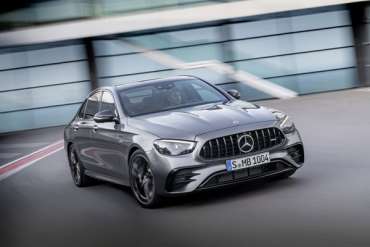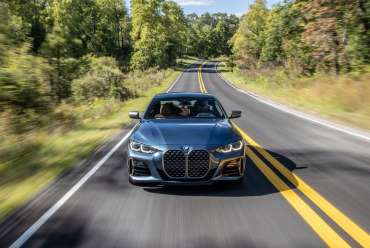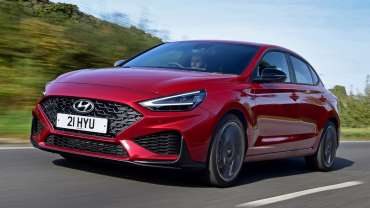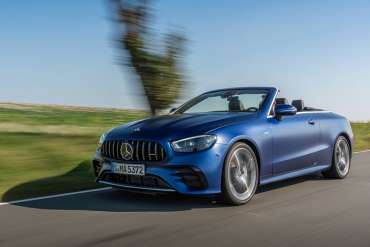
Worldcarblog.com
2022 Volkswagen Taos Previews an Important New Engine for VW
An early prototype drive in VW’s upcoming Taos subcompact ute reveal its new Miller-capable 1.5-liter turbo-four should enliven the low end of VW’s lineup.
Oxnard, California, is an overlooked American automotive nerve center. The city surrounds Port Hueneme, where massive car-carrying ships disgorge vehicles for at least 18 manufacturers. It's also the port from which Tesla vehicles leave for export to Asia. That's led some of the carmakers to establish engineering and design facilities in the area. BMW has one there. And now, so does Volkswagen of America—a five-acre campus on Del Norte Boulevard, across from a Shell station with an integrated Subway sandwich shop.
So, while VW was dazzling the world's assembled press in September with the all-electric ID.4 small crossover, it simultaneously invited a select group of marginalized journalists to Oxnard to tour the company's facility, sample the company's upcoming 2022 Taos—a conventionally powered compact crossover—and do a deep dive into its new 1.5-liter turbocharged, four-cylinder engine.
Nearly a foot shorter, the Taos is more compact than the Tiguan, sized to compete in the red-hot twerp-ute market, a burgeoning segment that includes the trendy Nissan Kicks, stalwart Honda HR-V, sweet Mazda CX-3, and lackluster Ford EcoSport. It's an important genre, not only because of its insane sales growth, but because cheap crossovers are often the entry point for young customers buying into a brand for the first time. And that's that for the business school marketing lesson.
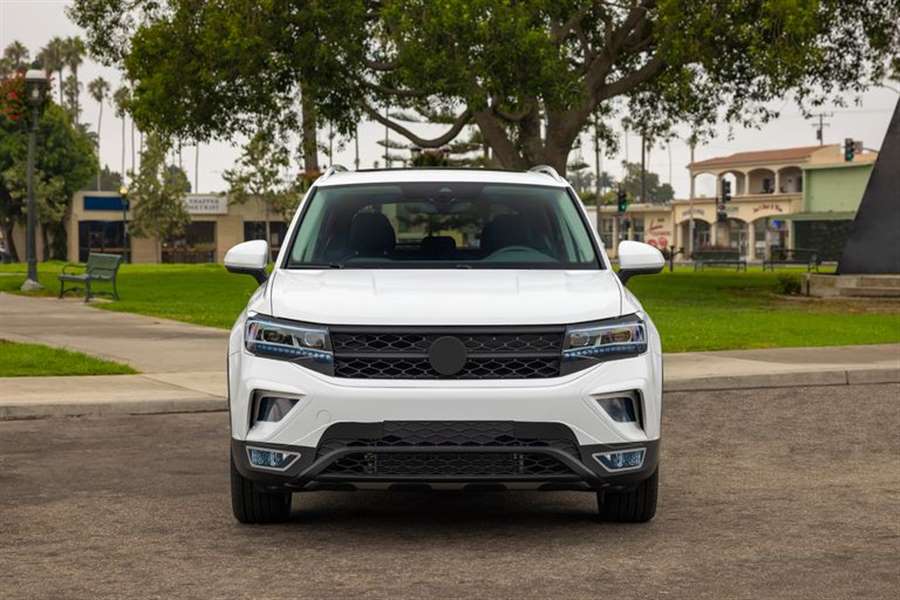
The pre-pre-production prototypes on hand were lightly camouflaged to avoid startling observers psychologically unprepared to contend with the profound visual impact of a small SUV that looks like a dehydrated Tiguan. On the outside they were wrapped in white vinyl, with subtle graphic elements taped to the headlights and covering the logos. On the inside, a fuzzy dash pad covered most everything but the tachometer and speedometer. That included the air vents, and it was a pretty hot day.
The drive itself would consist of a 30-or-so-mile lap through Oxnard and neighboring Camarillo and back to VW's campus. And during this tour of verdant, culturally diverse Ventura County, we would be shadowed by a VW representative so that if something went wrong or we tried to keep the prototype for ourselves, they could do … something. Maybe our proctor had a roll of duct tape with him. Or a shotgun. We obeyed the rules.
The featured attraction here was truly the new 1.5-liter turbo engine. It's destined to replace the 1.4-liter turbo four that's currently the standard powerplant in the United States-market Jetta and Golf. The 1.5-liter has a slight increase in piston bore diameter to reach its new displacement, but the big change is the use of some technology from the EA888 turbocharged 2.0-liter inline-four found in the Tiguan. The new engine will be capable of operating on Volkswagen's modified Miller-cycle combustion under light load conditions, which they've named the Budak cycle after its developer. When operating on Budak, the intake valve closes earlier that it would during normal operation, thus reducing the amount of fuel and oxygen drawn in and returning more efficiency. The 1.5-liter will also use a variable vane turbocharger to increase its responsiveness.
VW rates the new engine at 158 horsepower and 184 pound-feet of torque, which will be the sole engine in the Taos. That vaults right over competitors like the 141-hp Nissan Rogue Sport, 147-hp 2.0-liter Kia Soul, and 148-hp Mazda CX-3. And the VW will push that advantage by backing the engine with an eight-speed conventional automatic transmission in front-drive versions of the Taos. All-wheel-drive versions will get the familiar seven-speed dual-clutch transmission. The new 1.5-liter will be built at VW's engine plant in Silao, Mexico, which opened in 2013. And the Taos, designed for the North American market, will also be built in Mexico.
The route chosen for us by VW was flat and not curvy. There was a short blast southward on Highway 101, but no roads were challenging. There were several opportunities along the way, however, to stop and buy strawberries freshly picked from the coastal plain's fields.
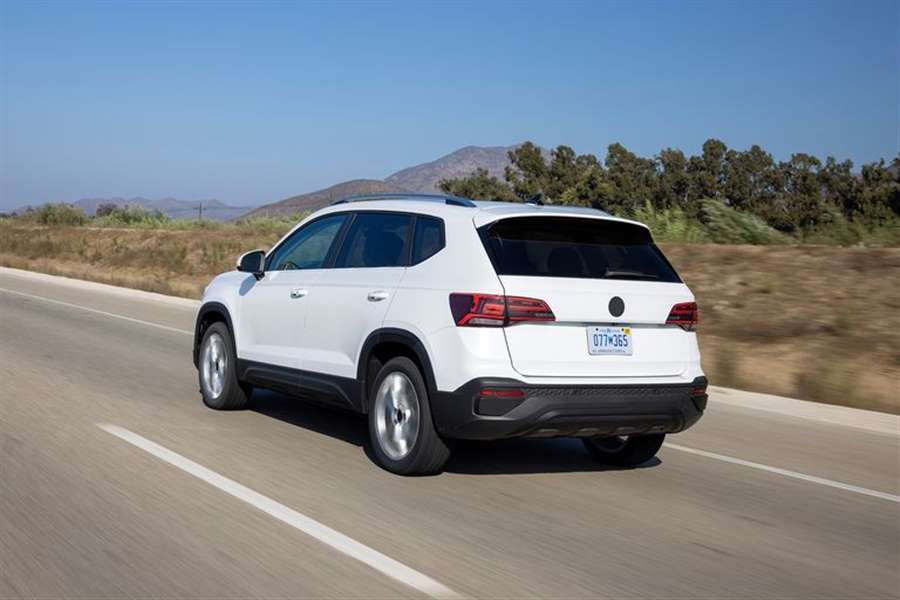
As an evaluation of the Taos, this was just a bit of early exposure, severely limited in its usefulness. But the engine does seem to make excellent low-end grunt, the transmission didn't do anything untoward, and the suspension didn't collapse riding along smooth pavement. The details that matter were covered up inside, so there's no way to positively say how well the interior is laid out. Naturally, a big-ass touchscreen is likely destined for the dashboard's center because everything now has a big-ass touchscreen.
The front wheel-drive Taos will make its official debut this month and is scheduled to hit dealerships around the middle of next year. And since it's destined to compete in one of the most price-conscious segments of the market, there's no reason to expect it to cost any more or much less than other cute-overs. So, figure it'll start at around $20,000 at the bottom and knock on $30K at the top of the range.
Back at the facility, there were Volkswagen products from around the world on hand for all sorts of testing. There were even a couple of prototype ID.4s, with technicians carefully peeling away their camouflage after that day's public debut of the car. There's something going on here.
That something is an inflection point, one where manufacturers are still developing vehicles powered by internal combustion engines while simultaneously prepping for the electrified future consumers will either want or will have forced upon them. Volkswagen was caught with its pants down in the diesel scandal and can't afford to screw up in the immediate future. So, right now it's wearing multiple pairs of pants. Jeans and chinos. Dockers and slacks. Snow pants and baggy shorts.
As the day was dying off, the assembled litter of journalists were led to a conference room set up with appropriate social distancing. There we enjoyed the comedy stylings of Johan de Nysschen, the still new senior executive of Volkswagen Group North America, who is this generation's Bob Lutz tinged with a hint of John Force. He likely said something profound and hilarious, but I really just wanted to write "comedy stylings."
It turns out that VW doesn't use Port Hueneme as a port of entry for its vehicles. So, why the company decided to plop down its latest facility in Oxnard is a mystery. Maybe it's because Oxnard is where the action is. Or maybe they just wanted to build somewhere with easy access to a Subway.
Source: caranddriver.com
Lexus LC Convertible reviews
Luxury convertibles will never be big sellers, but Lexus intends the LC Convertible to be even more exclusive than most. Only planning to sell a few hundred a year should mean this car remains seriously desirable – that’s if its eye-catching looks and the allure of a powerful and characterful V8 engine aren’t enough to do that.
But being a Lexus, the LC Convertible has to be many things other than desirable. Traditional Lexus owners won’t accept anything half-baked; this is a car that has to be screwed together with more care than your average IKEA bookshelf, and one that has to be totally, completely painless to own.
Lexus LC Coupe review
As for rivals, this car can count everything from the Porsche 911 Cabriolet to the Mercedes S-Class Convertible – though at this end of the market, people are much more likely to be buying with their hearts than their heads, and while boot space or miles per gallon do matter, it’s character, presence and enjoyment that will convince these buyers.
Fantastic looks with folding fabric roof
It would seem folding hard-tops have almost had their day, and most premium convertibles – the LC Convertible included – now opt for a fabric hood instead. This has several benefits and in this case it’s speed of operation, weight distribution and looks that all benefit.
With switches hidden away carefully under the interior palm rest, raising or lowering the roof is done at the touch of a button. It takes just 15 seconds to raise or lower, and can be done at speeds of up to 31mph – so you can raise or lower to your hearts content while driving around town, in accordance with any sudden rain storms that might pass your way.
The lightweight roof mechanism means more of the LC’s weight is lower down, lowering the centre of gravity which improves cornering and comfort. Better yet, Lexus has worked hard on making sure that the roof is attractive even when it’s raised – not always a given with some cars, which can look rather tent-like.

Only one engine option – but it’s a great one
While the standard LC Coupe is offered with a petrol/electric hybrid option (badged LC 500h) the Convertible doesn’t get this – the weight distribution would be thrown off too much by the heavy battery pack. Instead, Lexus only offers it in what it calls LC 500 form – that means a whacking great 5.0-litre V8 petrol with no hybrid assistance whatsoever.
It’s as old-school a combination as you can find these days. The engine puts its power to the rear wheels, and is unencumbered by turbocharger or supercharger. This means it feels purer – the response is beautifully crisp, and it only gets better as the revs climb. In fact, the engine’s full power isn’t accessed until you hit 7,100rpm.
The engine’s paired up to a ten-speed automatic transmission and rear-wheel drive, which provide effortless cruising when needed for long motorway slogs and a great deal of fun for the twisty bits in between.
Impressive interior – but not exactly spacious
You sit very low in the LC, in large, comfortable sports seats with loads of adjustment. And once inside, you’re surrounded by an interior only Lexus could have designed – with Japanese influence in its surfacing, and thought paid to its construction.
Though the LC Convertible does have rear seats, they’re not really intended to be used for passengers. Most owners will opt to see them as additional luggage space – useful, especially as the LC Convertible’s boot is smaller than most city cars.
Naturally there is plenty of luxury equipment, and the LC Convertible has been launched alongside a minor model change for the LC line as a whole – which means that both Coupe and Convertible now come with Apple CarPlay and Android Auto connectivity, a real boon for those who find Lexus’ aging and labyrinthine infotainment system worth avoiding.
Practicality
The Lexus LC Convertible is a four-seater in theory, but it’s at its best when used as a two-seat roadster. The two front seats are excellent – they’re set incredibly low to the ground, making for a really comfortable yet focussed driving position with plenty of adjustability.
Lexus seats are typically a strong point and though the larger motorist might feel as though their bottom is a little pinched by the side bolsters, for most it’s effortlessly comfortable.
The driver certainly feels ensconced, surrounded by high sills to the windows – which doesn’t do much for visibility but certainly makes it feel more like the cockpit of a fighter jet.
The two rear seats… well, they exist, but ask a six-foot adult to sit back there and they’ll laugh. However, there are two Isofix child seat mounting points back there, making it possible that you could bring children along with you. You’ll need to be very mobile to belt them in, however, and we can’t imagine big, bulky baby seats will fit very easily either.
Boot
The rear seats are better treated as an extension of the boot space, though there’s no way to fold them down to allow for longer loads. At 149 litres in capacity, the LC Convertible’s boot is similar in size to the front trunk of a Porsche 911 Cabriolet. It’s rather wider and shallower, though – useful for fitting in a couple of carryon suitcases or several soft bags.
Safety
Tons of safety kit
Hasn’t yet been tested by Euro NCAP
Lexus has a strong record for crash safety
Neither the LC Convertible nor its coupe sibling have been tested by Euro NCAP for crash safety, but Lexus’ reputation for solidity and assurance extends to its safety record. Every Lexus model ever tested by Euro NCAP has received a full five-star rating, with the most recent ES saloon and UX SUV posting really impressive scores.
In terms of safety equipment, the LC Convertible is fully loaded regardless of which grade you choose. All models come with what Lexus terms the ‘Safety System +’ – a package of aids that includes adaptive cruise control, autonomous emergency braking, traffic sign recognition, lane-keep assist and automatic high beam headlights.
There are also eight airbags and blind-spot monitoring, plus pop-up bars that shield the occupants heads should the worst happen and the car rolls onto its roof (or lack thereof).
Interior
As befits a Lexus, the LC Convertible has an interior that’s distinctive in style. The overarching factor is how beautifully it seems to have been built – another Lexus hallmark. There are no rattles or creaks in here, no matter where you search for them, and material quality is high even in places you’re not likely to touch. Almost every surface is either leather or dense, expensive-feeling plastic.

There’s a high-set centre console containing a tiered central stack – this holds climate controls and a large single air vent for the driver, while lower down there are nicely weighted controls for the stereo and a touchpad for the infotainment system.
Further up there’s a vertically-orientated panel that features a textured finish to keep things interesting, as well as a digital gauge cluster. Like all high-end Lexuses, this actually features a moving, physical bezel – depending on what you’re doing, it’ll slide over to make more room for sub-menus and controls. It’s daft, but high-end features intended to delight often are. The cluster itself is easy to read, though looking a little low-res next to the ultra-sharp panels fitted to cars such as the Audi R8.
There are no such complaints for the central infotainment screen, which is ten inches across and looks bright, colourful and sharp. Lexus’ own interface offers everything from sat-nav to trip data, but it’s confusing and difficult to navigate the menus – especially since it’s not a touchscreen.
Instead, Lexus demands you use the touch-sensitive pad by the gearlever to move a virtual pointer, like you would on a computer. It’s slicker than past efforts, but still torturous to use when inputting an address, for example.
Luckily, Lexus has finally bowed to public pressure and installed Apple CarPlay and Android Auto in the LC Convertible. These allow you to replace Lexus’ interface with one pulled directly from your smartphone. We found Android Auto worked well, and while you still needed to navigate with the pointer it was much easier simply to use Google’s voice control to accomplish most tasks.
There are two USB ports for charging and connecting phones, and they’re situated underneath the central armrest. Pull this armrest back a little and you’ll be able to flip up the palmrest ahead of it – underneath, cleverly concealed, you’ll find the controls for the roof.
Other storage space is somewhat limited, with a shallow central bin and thin glovebox. The door bins are adequately sized, though, and there’s a big cupholder conveniently situated ahead of the gearlever. Passengers also get a grab handle on the centre console, to keep them steady when the driver’s having a little fun.
Comfort
Low-speed ride a little choppy
Irons out every bump when moving faster, though
Seats are excellent
With large wheels and the stiff suspension of the Sport+ model we tested, the Lexus LC Convertible can be a little unforgiving when driving around town. It’s far from unbearable, but those hoping for a cushioned ride around the city should probably look towards something like a Mercedes-Benz E-Class Convertible.
2020 Lexus LC Convertible - front trackingEnlarge0videoEnlarge14photo
When moving faster, that becomes much less of an issue – at the national speed limit, the LC floats over bumps almost as if they weren’t there. Absorption of road imperfections is aided by the excellent and supportive seats.
Source: parkers.co.uk
2021 Toyota Sienna Review: A Strange Brew
The verdict: The redesigned 2021 Sienna is Toyota’s gambit to avoid a cookie-cutter minivan at all costs. It’s refreshing in some ways, but other aspects will make you wish the automaker had stuck to a more conventional approach.
Versus the competition: As you might expect for any redesigned minivan, the new Sienna has more family-friendly features than you can shake a pogo stick at. Less characteristic of the class, it boasts a risk-taking interior and a hybrid-only powertrain — qualities that could turn away as many shoppers as they attract.
With styling inspired by Japan’s bullet trains, the Sienna courts minor controversy by way of a gaping lower grille, but Toyota’s been pushing a big grille since it refreshed the minivan late in the prior generation. On sale in November, the 2021 Sienna model comes in five trim levels: LE, XLE, XSE, Limited and Platinum, all with a four-cylinder hybrid powertrain and front- or all-wheel drive. We evaluated two preproduction AWD examples: an LE and XSE.
Hybrid Only
Toyota’s decision to offer the Sienna as a gas-electric hybrid comes as little surprise given the automaker announced plans in 2017 to offer electrified variants across its entire lineup by roughly 2025. More curious is the decision to offer the Sienna only as a hybrid, in this case with a 2.5-liter four-cylinder plus an electric drive motor. Total output is 245 horsepower, with another electric motor at the rear axle facilitating AWD if equipped. Toyota claims the same 3,500-pound towing capacity as before, plus EPA-estimated combined mileage of 36 mpg (FWD) or 35 mpg (AWD). The agency has yet to publish figures, but it’s safe to say the 2021 Sienna’s fuel efficiency will smoke that of the outgoing Sienna, which in its final years offered only a non-hybrid V-6.
What’s also clear: The new Sienna loses a step to the outgoing model, which made 296 hp, though the deficit isn’t as bad as it looks on paper. Step on the gas, and the hybrid drivetrain’s electric motors lend immediate oomph from a stop, but engine power then raises revs noisily and a little out of sync with your right foot. Power comes soon enough, but maximum acceleration is a bit slower than the old Sienna. The new drivetrain seems optimized for power transitions when you’re already in motion; go from some pedal to more pedal, and power comes with little delay.
Ride and Handling: Base Is Best
Ride quality depends largely on what you get. Equipped with 17-inch wheels with P235/65R17 tires, the Sienna LE absorbs bumps with clean, high-quality composure, though some roads can produce slight, lateral body movement. The XSE AWD pairs a sport-tuned suspension with 18-inch wheels and P235/60R18 tires, meanwhile, and the result is firm. Shock absorption feels altogether less sophisticated, with harsh impacts and more jittery body movement. Front-drive XSEs have 20-inch wheels with even lower-profile tires (P235/50R20s) that may be even more harsh.
Little payoff comes on the handling front, as the LE’s dynamics seem just as good as the XSE’s without the undue firmness. With the battery pack behind the front axle, under the front seats, the Sienna maintains steadfast balance hustling around sweeping corners. It steers with light effort and direct response, though feedback is numb enough to allow excessive wandering on center — especially in the LE, which lacks the XSE’s sport-tuned steering. The XSE’s sport suspension allows slightly less body roll, but the regular setup still corners reasonably flat for what this is. And the tires on both minivans (Bridgestone Turanzas on the XSE and Falken Ziex on the LE, both all-seasons) exhibit good lateral grip.
Unconventional Interior
Draped with hulking shelves and a wide bridge-style center console, this Sienna sports the most left-field interior for a Toyota minivan in the U.S. since the Previa. Gone is the old Sienna’s drop-down center console and floor-level space to throw a medium-size purse, a layout still offered in the rival Honda Odyssey and certain variants of Chrysler’s Voyager and Pacifica siblings. In its place is a massive flow-through console that bridges the dashboard and center armrest. Underneath it is a large storage area with … enough space to throw a medium-size purse. It’s a wide setup overall, but so is the driver’s berth; even for long-legged adults, the console shouldn’t clip your knees. If it does, Toyota pads the outboard section to minimize discomfort.
Cabin quality in our preproduction test cars was all over the map, with harsh, cheap-looking finishes over much of the dashboard and insufficient padding in areas like the upper doors. The LE has a decent grade of cloth upholstery, but the XLE and XSE have SofTex vinyl, which (at least in our XSE example) imparts a rubbery industrial feel; Limited and Platinum models get leather. Toyota routed hardware for the mechanical gear selector down the front side of the console bin — a nice bit of packaging enabling the bridge-style console that usually requires the electronic selectors we universally dislike — but the selector’s rickety operation feels like it’s falling apart. Some of that might improve by production time, but this isn’t the first Toyota we’ve driven to have a shaky gear selector.
Among the console compartments, dashboard shelves and umpteen door pockets, the Sienna still has plentiful storage space. It also boasts decent forward visibility thanks to door-mounted mirrors and thin A-pillars. Rear visibility is less ideal, with bulky second-row head restraints blocking over-the-shoulder sightlines and a backup camera in dire need of better resolution. Higher trim levels offer a camera-based rearview mirror and 360-degree camera system, which we did not evaluate.
A 4.2-inch gauge display and 9-inch touchscreen, the latter with Apple CarPlay and Android Auto, are standard. Although wireless smartphone charging is optional, both smartphone integrations still require physical cords, not the wireless connectivity gaining traction industrywide. Spaced across all three rows are seven standard USB ports, including three of the newer USB-C variety. Options include a 7-inch gauge display, two household-style AC outlets, an 11.6-inch rear entertainment system and head-up display.
Winsome Seating …
LE and XLE models seat eight courtesy of a three-position bench with a removable middle seat in the second row. Optional on the XLE and standard on higher trims are second-row captain’s chairs, which reduce capacity to seven. In any case, space is plentiful all around, though accessing the third row from either side remains a cumbersome, multistep process. Fortunately, the second-row seats have exceptional sliding range — about a foot (in a seated position, farther for access) in base models or roughly double that with an optional extended-slide feature — to find a position that lends adult-friendly legroom in both rows.
Typical of a minivan, the Sienna’s third row folds backward into a floor cavity. Stow it there, and the available extended-slide captain’s chairs go nearly as far back as the third row once sat, with enough legroom ahead to host a soccer match. Like the outgoing Sienna, the 2021 model offers pop-up leg rests for passengers to lounge while the van is stopped, but these seats slide 10 inches farther than before, Toyota officials told us.
… Lose Some Cargo
Alas, the versatile seating arrangement comes at significant expense to cargo space. Regardless of configuration, the second-row seats neither fold down nor come out, provisions the Odyssey and Pacifica offer. Toyota says that’s because of new airbags mounted in the second-row seats. Curtain airbags are also standard, and the second row in plenty of cars — including the outgoing Sienna — fared well in side impact crash tests with curtains alone. For the 2021 Sienna, Toyota says the extended-slide seats necessitated the extra pair of airbags.
“Adding airbags to the seats allowed us to include the super-long slide,” said Nicky Hamila, a spokesperson for the automaker. “That would only be possible with airbags in the seats that travel with the seat and [protect] the occupant in every position.”
Still, the explanation doesn’t justify why chairs without the extended-slide feature still have the extra airbags and no removability. In any case, maximizing cargo room requires locking the second-row chairs into a collapsed forward position, similar to a provision in the old Sienna. But for maximum room, the old chairs were fully removable. These are not, and the seatbacks lean forward but don’t fold horizontal to maximize usable cargo depth. Toyota says the new Sienna can still fit 4-by-8-foot sheets of plywood at an angle from floor to seatback, but the setup nonetheless reduces roughly 8 feet of potential cargo depth at floor level down to about 6 feet with the seats collapsed forward, by our measuring tape. In other words, if you need to transport bulky furniture, the non-removable seats reduce maximum cargo room by about a quarter.
Behind the second row, cargo specs are relatively more competitive. With the XSE’s third row folded into the floor and its extended-slide second row at the midpoint of its sliding range — a realistic comparison with other three-row vehicles, which universally have much less sliding range — we measured 44.6 cubic feet of cargo room behind it. (We also measured the space with the chairs positioned all the way back, and the volume behind them was 32.6 cubic feet.) The first figure is competitive: We logged 41.6 cubic feet behind the second row in a 2021 Honda Odyssey, for example. It also underlines the sheer packaging efficiency of minivans at large. We measured 41.8 cubic feet behind the second row of a 2021 Chevrolet Suburban, a full-size SUV that’s nearly 2 feet longer.
Behind the third row, we measured 21.7 cubic feet of volume in the Sienna. That’s competitive with our measurements for the Odyssey (21.1 cubic feet) and, for that matter, the Suburban (23.0 cubic feet). Of note, our Sienna XLE lacked an optional spare tire; getting one would eliminate a wall cubby in back, subtracting about 1 cubic foot from our measurement.
Safety
Third-party crash tests have yet to be published for the 2021 Sienna as of this writing. Besides the aforementioned airbags — which make for 10 in total — the Sienna has an impressive roster of crash-avoidance technology, including full-spectrum automatic emergency braking with pedestrian detection, lane departure alert with steering assist and a blind spot warning system. On the driver-assist front, hands-on lane-centering steering and adaptive cruise control work all the way down to a stop; both are also standard. For parents with smaller children, a rear-seat reminder employs door sequencing logic, while the second and third rows have two or three sets of Latch anchors apiece, depending on trim.
Features and Pricing
The Sienna’s base price jumps some $3,000, but that’s because the outgoing model offered a budget-priced L grade that’s now discontinued. The LE starts just north of $35,500 with destination — a little steep for the class — but comes well equipped. Standard features include dual power sliding doors, tri-zone automatic climate control, one-touch power windows all around, a power driver’s seat, cloth upholstery, second-row sunshades and the full-fledged multimedia system.
At the other end, a loaded Sienna Platinum AWD tops out in the mid-$50,000s. That’s a few thousand more than the outgoing Sienna, though it’s a competitive — if eye-watering — price for an AWD minivan. Additional features en route to that price include vinyl or leather upholstery, a hands-free power liftgate, the rear entertainment system, JBL premium audio, heated and ventilated seats with dual power adjustments (though no height adjustment for the passenger), and heated second-row seats. Options uncommon to the class include quad-zone climate control and a power-adjustable steering column. On the flip side, there are no immediate plans to offer a panoramic moonroof or camera system to monitor passengers, two features offered by some rivals.
Toyota also plans to offer an onboard vacuum cleaner and refrigerator at some point. Officials said both features won’t be available at launch but are coming later on; however, they declined to provide a timeframe beyond that.
Should You Buy One?
Minivans have long thrown a smorgasbord of features at family shoppers, and the 2021 Sienna serves up as much as the rest of them. But its qualities feel a little more niche than before. If anything, the fourth-gen Sienna seems ready for a contingent of fastidious fans, even if other audiences shrug it off as something not mainstream enough. Minivan shoppers should add it to the list, at minimum because that list is so short. Whether you buy one will depend on whether you find Toyota’s new direction welcome or just plain odd.
Cars.com’s Editorial department is your source for automotive news and reviews. In line with Cars.com’s long-standing ethics policy, editors and reviewers don’t accept gifts or free trips from automakers. The Editorial department is independent of Cars.com’s advertising, sales and sponsored content departments.
Source: cars.com
Mercedes-AMG E 53 2021 Launched With 423BHP
Mercedes has unveiled an updated version of its entry-level AMG E 53 performance saloon, hot on the heels of the facelifted standard E-Class range. The brand’s updated rival for the Audi S6 is on sale in the UK now, with prices starting from £64,750 for the saloon and £66,750 for the estate.
The updated AMG E 53 4MATIC+’s styling tweaks mirror those of the standard E-Class range, albeit with a more hardcore appearance. Up front, there’s a new radiator grille which mimics the design of the AMG GT Coupe’s – and at the rear, there’s an aggressive new diffuser which houses a quad-exit exhaust system.
The E 53 is available in a choice of two trim levels. The base model features 19-inch twin-five-spoke AMG alloy wheels, a 360-degree parking camera, keyless go and AMG-branded brake calipers. Inside, buyers get a pair of leather-trimmed sports seats, carbon-fibre trim and Mercedes’s 12.3-inch dual-screen infotainment system.
The E 53’s infotainment set-up also includes AMG-specific functions, such as a lap timer, telemetry settings and track mapping. There’s a new flat-bottomed steering wheel, which is similar in design to the rest of the range, but is fitted with a pair of AMG buttons to adjust the car’s driving modes.
The more lavishly equipped AMG E 53 Night Edition Premium Plus is priced from £68,250 and adds a set of matte-black 20-inch alloy wheels, a panoramic glass sunroof, privacy glass, gloss-black window surrounds and an improved 13-speaker Burmester sound system.
Both E53s are powered by a turbocharged 3.0-litre straight-six petrol engine, which is supported by a 48-volt mild-hybrid system. Combined, the unit has an output of 423bhp and 520Nm of torque which, thanks in part to the car’s four-wheel drive system, is enough for a 0–62mph time of 4.5 seconds and a top speed of 155mph.
Like all Mercedes-AMG models, the E 53 gets a host of extra chassis technology, including adaptive dampers, a sophisticated five-stage traction control system, uprated disc brakes, dynamic engine mounts and a limited-slip differential for the rear axle. Read more > https://mercedes-world.com/e-class/mercedes-amg-e-53-launched
Source: mercedes-world.com
2021 BMW M440i xDrive Noses Away From Its Roots
The M440i xDrive's spectacular inline-six can't quite make up for the rest of the car.
Traditionalists will say the new 4-series maintains only a passing resemblance to a BMW, like an unlicensed rendering in a video game. They'll also note the attention-snaring vertically oriented grille. But what's most disappointing is that it's not as good to drive as we'd expect a sporty BMW coupe to be.
The 4's redesign catches it up to the current G20-generation 3-series. Although the two cars share a 112.2-inch wheelbase, the coupe is an inch or two longer, wider, and lower and has a wider rear track. That growth brings a larger rear seat that's tolerable for average-size adults. In profile, the 4 looks almost like a scaled-down 8-series, yet unlike the 8, it doesn't look quite so much like a Ford Mustang.
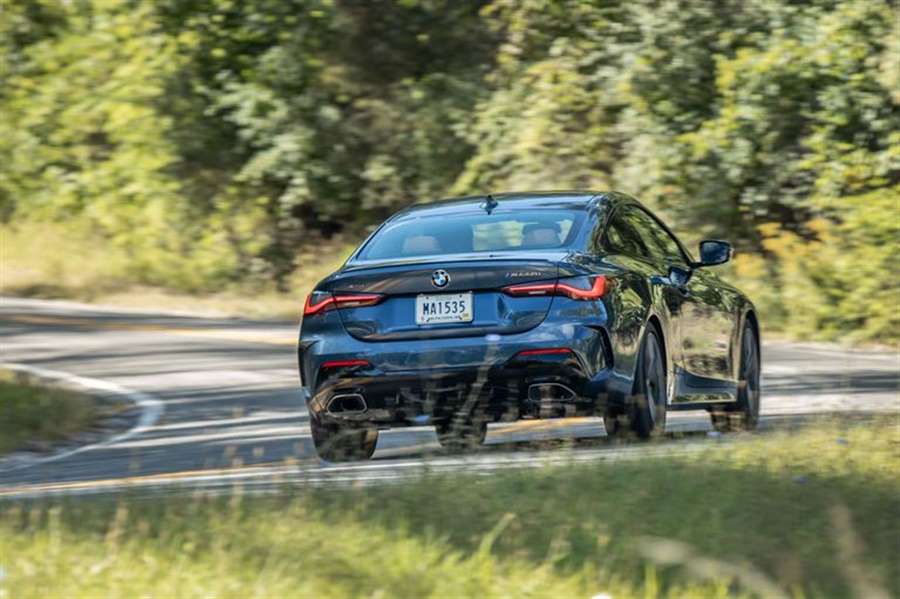
The update adds to the 4's curb weight. It's now basically a two-ton car in the top M440i xDrive trim, with our test car placing a substantial 53.8 percent of that mass on its front wheels. Even with 19-inch Michelin Pilot Sport 4S summer tires (18s with all-seasons are standard), it managed only 0.91 g of skidpad grip, and understeer dominates. We've recorded more stick from the newest 3-series and even some family sedans, although our car did stop from 70 mph in a short 149 feet.
The M440i's variable-ratio steering is short on tactility and has an almost rubbery buildup of force as you turn off-center. The rack's rather quick ratio only amplifies its artificial feel. Factor in the compliant ride from the adaptive dampers and the 4 has veered into grand-touring territory. It'll still happily hustle down a challenging road, but the experience isn't as satisfying as it used to be.
The M440i xDrive is still quick—3.8 seconds to 60 mph—thanks to the 382 horsepower from BMW's awesome turbo 3.0-liter inline-six. A new 48-volt motor-generator adds some pounds yet contributes up to 11 horses to assist the engine before the turbo wakes up. Lag is nicely mitigated as proven by the fleet 4.6-second time in our launch-free five-to-60-mph test. Sadly, a manual is no longer offered, but ZF's ubiquitous eight-speed automatic swaps gears as sweetly as ever.
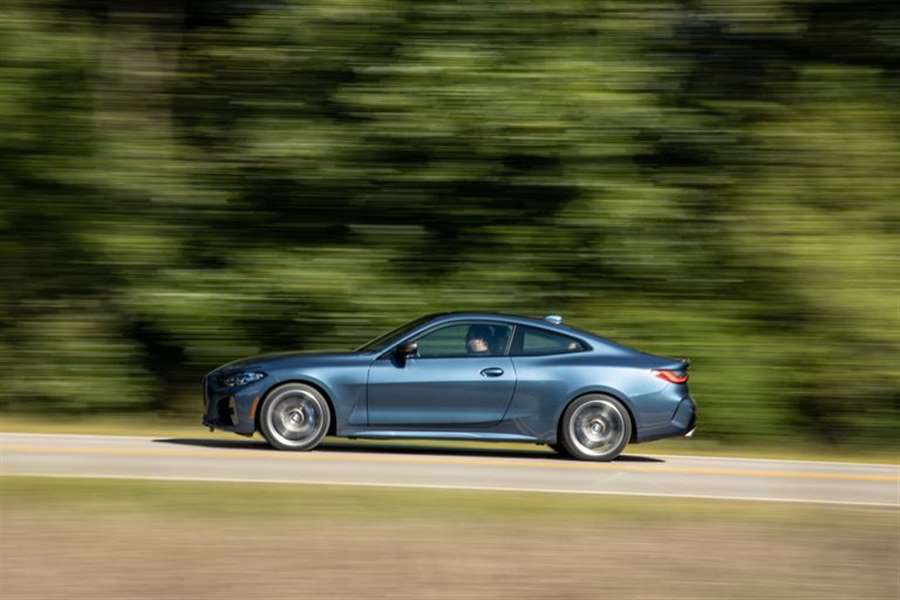
This being our first turn with the new 4, we're hoping other versions offer a closer connection. Our hope is the four-cylinder 430i model, which comes standard with non-variable steering and passive dampers, will carry the BMW dynamics torch of yore. It is currently the only 4-series available with rear-wheel drive, though a rear-drive six-cylinder model will be added later.
The fiery performance of the latest M3 and M4, both of which adopt similar vertical grilles, should help us acclimate to the controversial design. But the softer character of the M440i xDrive makes it tough to overlook the 4's new face.
Source: caranddriver.com
New Hyundai i30 Fastback N Line 2020 review
The new Hyundai i30 Fastback N Line looks great, but what's it like from behind the wheel? We find out...
The Hyundai i30 N Line Fastback certainly adds a little more excitement to the compact family car class, but behind the looks is a car that falls short in key areas. The sluggish dual-clutch gearbox and overly firm ride compromise the overall package and its ability as a family car. More sensibly-priced options lower down the range make for better family transport, while those wanting the looks and performance should try to find the extra cash for the fully-fledged N model.
Despite having been around for over 13 years - now half way into its third generation - the Hyundai i30 has never really gained the notoriety of its class rivals, such as the VW Golf or Ford Focus. It’s a competent, comfortable and affordable family car but remains a slightly left field choice in its class.
Hyundai has attempted to address that as part of the car’s mid-life update by introducing a new 158bhp 1.5-litre Fastback model that only comes in the firm’s racy N Line trim. The visual updates are minor but certainly go some way into making what was a rather forgettable-looking family car into something a bit more striking.
A new LED lighting signature and reshaped bumper sharpen up the front end, while gloss black trim on the lower edge of the bodywork and new 18-inch alloy wheels give a more purposeful look to the car. As a Fastback, the N Line makeover really does look the part.
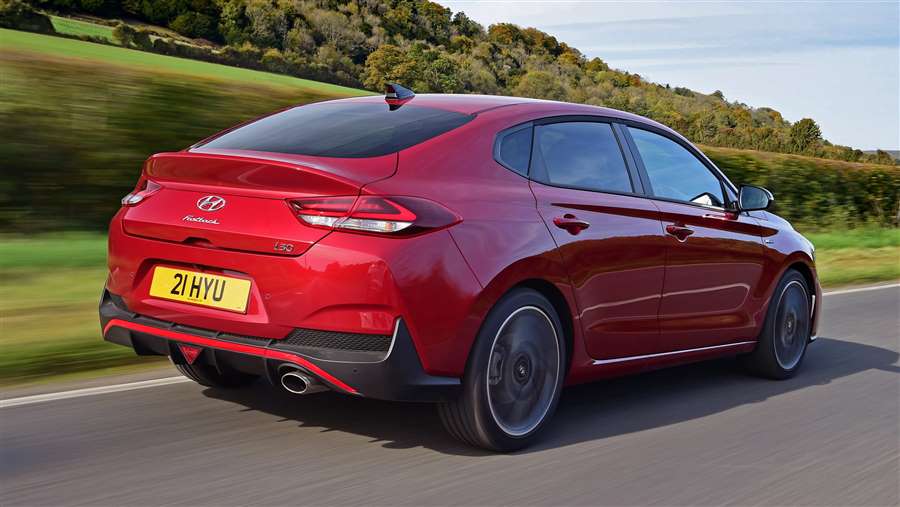
The engine is also new; the previous 1.4-litre four-cylinder turbo has been ditched in favour of a new 1.5-litre T-GDi that develops 159bhp and 253Nm of torque. Performance figures are brisk if not blistering, with Hyundai claiming an 8.8-second sprint from 0-62mph and a top speed of 130mph.
In our test car, the engine drives the front wheels through a seven-speed dual-clutch automatic gearbox. Hyundai’s six-speed Intelligent Manual Transmission is also available, which brings with it a £1,200 saving.
Opting to pocket that extra cash and go for the manual is probably a good idea, as on this evidence, the seven-speed DCT is one to avoid. Whether pulling away from a junction, accelerating to overtake on a dual carriageway or even if you’re just dawdling around town, the gearbox is sluggish and laboured at making changes. Despite being an N Line model, there are no steering wheel-mounted paddles for you to operate the gearbox with yourself, either.
The engine is smooth enough, assisted by the integrated 48-volt mild hybrid technology, but always hampered by the gearbox. However, it’s pretty efficient, nudging above 40mpg over a mix of roads on our test.
There might not be lots of power, but the chassis lets you make the most of it. The steering is part of a responsive front-end that resists understeer well and allows you to maintain momentum through a series of bends.
However, another gripe is the ride quality - or lack of it. Hyundai has seen fit to match the car’s racy new exterior with an equally sporty ride, but this i30 N Line doesn’t possess anywhere near the level of performance necessary to justify such a stiff suspension setup.
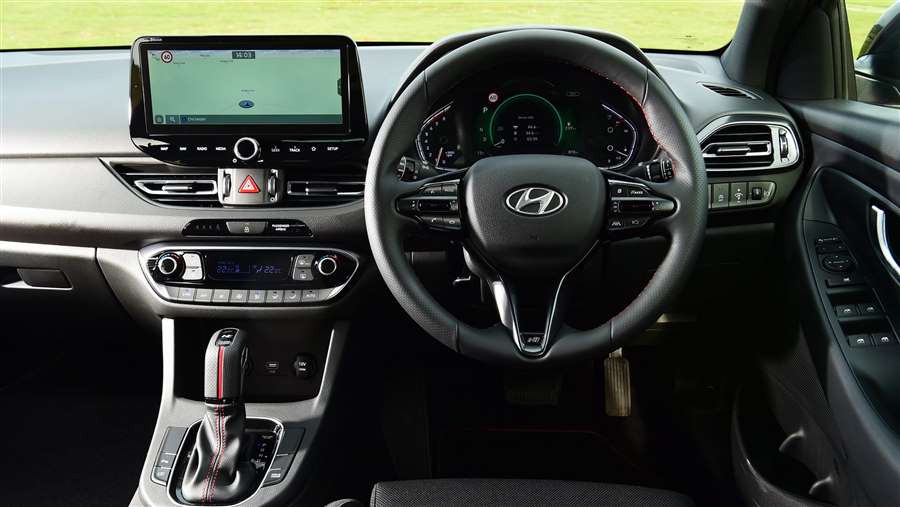
The car constantly fidgets and fights with the surface as you drive along, crashing over bumps that it really should soak up. The dampers are also passive - unlike the proper N model - so even as you cycle through the driving modes, there’s no improving the quality of the ride.
Inside, there have been some welcome tech updates, Hyundai adding a new 10.25-inch widescreen infotainment to the dash that’s compatible with both Apple CarPlay and Android Auto. Wireless smartphone charging and Hyundai’s new Bluelink telematics system, which beams real-time traffic and weather data to the car, have also been added.
A sticking point for most buyers, and what’s likely to make this i30 N Line quite a rare sight on UK roads is its price. At almost £27,000 tested here it’s only a few thousand short of the fully-fledged N car, which has the performance to match its looks. Over a three-year PCP deal, that’s likely to equate to only a few pounds extra per month.
Source: autoexpress.co.uk
2021 Mercedes-AMG E53 Cabriolet Delivers Both Speed and Grace
A freshened face and additional features adorn AMG's updated droptop E-class, but its high-tech inline-six remains as sweet as ever.
The hierarchical nature of model positioning means it is easy to view the 2021 Mercedes-AMG E53 as less desirable than the AMG 63 S sitting above it in the E-class range. Yet, such a judgement is unfair. The considerable talents of AMG's gently electrified six-cylinder give it a different character than the range-topping V-8 but one that's almost as equally compelling. In those variants where both powerplants are offered, it is entirely justified to prefer the smaller engine on grounds other than sheer parsimony. With the stylish E-class cabriolet, however, the point is moot. The AMG E53 is where the convertible tops out.
Some will bemoan AMG's continued refusal to combine the sonorous muscularity of its twin-turbo 4.0-liter V-8 with the cabriolet body. But the electrically assisted 3.0-liter inline-six of the AMG E53 proves almost perfectly suited to the car's laid-back driving manners. A mid-term facelift for 2021 hasn't wrought any significant mechanical revisions—power and torque figures remain unchanged—but it has brought more toys and revised styling to the range-topping cabriolet.
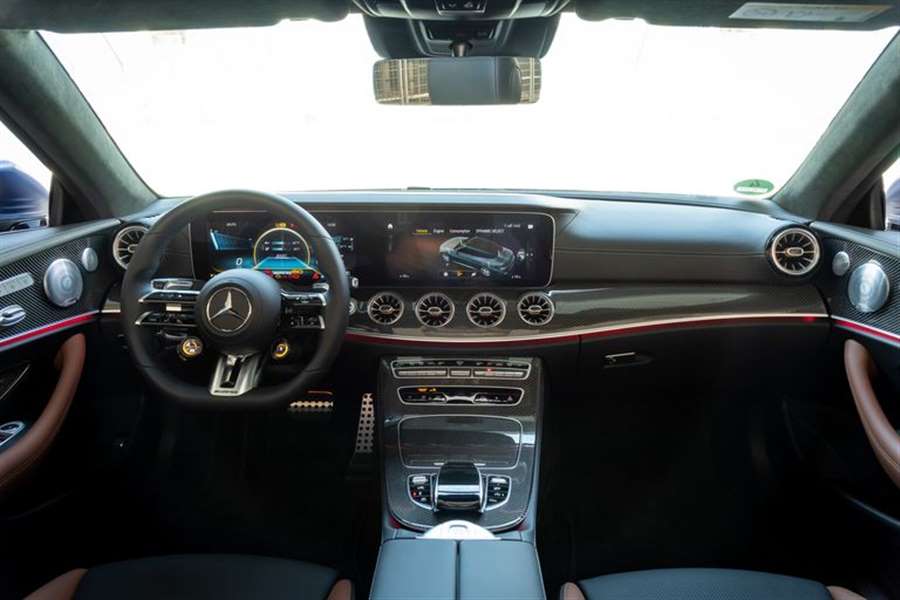
As with the E-class sedan and wagon, the cabriolet and closely related coupe get a heavily revised front end with new headlights and a radiator grille apparently inspired by the W194 300SL racer that won the Carrera Panamericana in 1952. Narrowed at the top and wider at the bottom, this is effectively an inverse of the pre-facelift grille and one that we think better suits the car. Changes at the rear end have been more limited, the E-class cabriolet (and its coupe counterpart) getting taillights with new internal elements. As before, the AMG E53 gets quad exhaust pipes beneath the rear bumper. The lesser E450 makes do with slightly squashed-looking dual exhaust tips.
More obvious changes are evident in the cabin, which remains spacious and extremely well-finished but which has migrated to the latest version of Mercedes's MBUX infotainment system. This is certainly crisper looking than the old setup and adds high-tech features like augmented-reality navigation, which superimposes direction-pointing arrows onto a live video feed when approaching intersections, but we found the system lacking in intuitive smarts and sometimes complicated to operate. Mercedes also gave the E53 a new four-spoke steering wheel to provide real estate for a proliferation of touch-sensitive controls, many of which replicate functions still served by surviving pre-facelift buttons. Buyers will doubtless get used to the complexity—or shortcut it with the smart "Hey, Mercedes" voice assistant—but we are increasingly nostalgic for the recent past when Benz's user interface was both simple and intuitive.
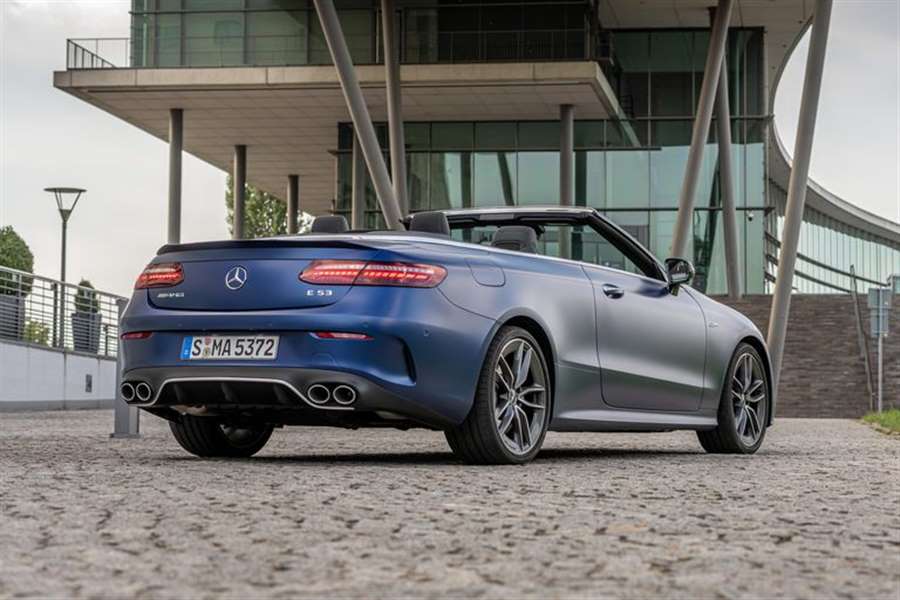
Beyond mild ergonomic niggles, the rest of the driving experience impresses all the way. The E53 powertrain continues to use a very clever 3.0-liter inline-six that has both a conventional exhaust-driven turbocharger and an electrically powered 48-volt compressor that adds boost at lower engine revs. The six is paired with a substantial integrated starter-generator that, although it can't power the car by itself, is able to add up to 21 horsepower and 184 pound-feet of torque to the combustion engine's output of 429 horsepower and 384 pound-feet. (The lesser E450 uses the same engine and starter-generator but lacks the e-turbo.)
The powertrain's complexity remains effectively invisible. All the E53 driver will experience is the combination of effortless low-rev muscle—with a total absence of detectable lag—and an impressively bristly top end. No, the six-cylinder can't match either the firepower or theatrics of the E63 S, but it is still able to deliver forceful acceleration when unleashed. The last E53 coupe that we tested blasted its way from zero to 60 mph in just 4.1 seconds, and we expect about the same for the slightly heavier cabriolet. Only at high speeds does the E53 start to feel anything less than blisteringly quick. On a stretch of limit-free German autobahn on our test route, the rate of acceleration fell away above an indicated 125 mph, a speed at which the E63 S sedan kept pulling at a barely diminished rate. While obviously lacking a V-8 soundtrack, the E53 makes some impressively muscular noises under hard use, with the Sport and Sport Plus modes allowing for some pops and crackles on upshifts and when the accelerator is lifted at higher revs.
The punchier dynamic modes sharpen the rest of the E53 driving experience, too, although not one turns it into a true sports car. Air springs and adaptive dampers are firmed up in the more aggressive settings but not sufficiently to corrupt the cabriolet's ride. Nor does the body control feel wayward in Comfort mode, the cabrio's 4600-pound mass kept in check over the roughest surfaces we could find. The weight is more obvious when asking the car to change direction quickly, and with the cabriolet's roof stowed we did notice slight evidence of the car's weakened structure, the rearview mirror vibrating slightly over certain road surfaces. The cabriolet's steering delivers crisp cornering response, although little natural feel passes beyond the generous power assistance. Traction from the quick-acting 4Matic all-wheel-drive system is impeccable on dry pavement. It takes an unsympathetic level of abuse to persuade the E53 to relinquish any rear-end grip.
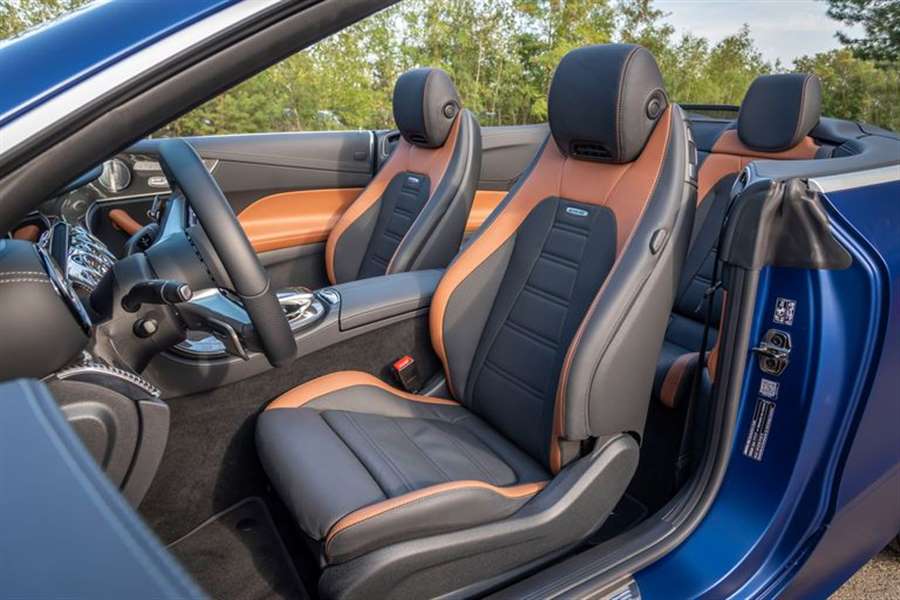
The E53's hybrid powerplant remains almost perfectly suited to the cabriolet's dynamic demeanor—rapid but relaxed, adding character without dominating the experience. Even cruising at speed with the roof folded, the E-class cabrio's cabin is impressively free of drafts or buffeting. The Airscarf system directs hot air to the top of the seats, making it possible to enjoy top-down driving in conditions that would be too chilly for most convertibles. The nine-speed automatic gearbox is also smoother at lower speeds than on V-8-powered models, where AMG replaces the torque converter with a wet-clutch pack.
Luxurious cabriolets have been part of Mercedes's offerings in the United States for as long as the brand has been selling cars here, but that might not be the case for much longer. We know that the future of all the brand's cabrios (and conventional coupes) are under review in the face of sliding sales. Losing a car like this would be a huge shame. The E53 continues to feel like a high point for both its brand and its wider genre.
Source: caranddriver.com

